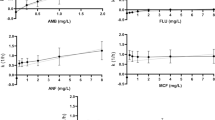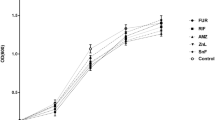Abstract
Trichosporon asahii (T. asahii) is an opportunistic pathogen that can cause life-threatening infections in immunocompromised patients, with high mortality rates up to 80% despite treated with antifungal drugs. The biofilms-forming ability of T. asahii on indwelling medical devices may account for the resistance to antifungal drugs. Berberine (BBR) has been demonstrated to have antifungal activity and synergistic effects in combination with antifungal drugs against pathogenic fungi. In the present study, the in vitro activities of BBR alone or combined with fluconazole (FLC), itraconazole (ITC), voriconazole (VRC), caspofungin (CAS) and amphotericin B (AMB) against planktonic forms and biofilms of 21 clinical T. asahii isolates were evaluated using checkerboard microdilution method and XTT reduction assay, respectively. The fractional inhibitory concentration index (FICI) was used to interpret drug interactions. BBR alone did not exhibit significant antifungal activities against both T. asahii planktonic cells (MICs, 32 → 128 μg/ml) and T. asahii biofilms (SMICs, >128 μg/ml). However, BBR exhibited synergistic effects against T. asahii planktonic cells in combination with AMB, FLC and CAS (FICI ≤ 0.5) and exhibited synergistic effects against T. asahii biofilms in combination with AMB and CAS (FICI ≤ 0.5). BBR/ITC and BBR/VRC combinations yielded mainly indifferent interactions against T. asahii planktonic cells. BBR/FLC, BBR/ITC and BBR/VRC combinations also yielded indifferent interactions against T. asahii biofilms. Our study highlights the therapeutic potential of BBR to be used as an antifungal synergist in combination with antifungal drugs against T. asahii infections, especially BBR/AMB combination. Further in vivo studies are needed to validate our findings.
Similar content being viewed by others
References
Colombo AL, Padovan AC, Chaves GM. Current knowledge of Trichosporon spp. and Trichosporonosis. Clin Microbiol Rev. 2011;24:682–700.
Hickey PW, Sutton DA, Fothergill AW, et al. Trichosporon mycotoxinivorans, a novel respiratory pathogen in patients with cystic fibrosis. J Clin Microbiol. 2009;47:3091–7.
Motaung TE, Albertyn J, Kock JLF, et al. Trichosporon vanderwaltii sp. nov. an asexual basidiomycetous yeast isolated from soil and beetles. Antonie Van Leeuwenhoek. 2013;103:313–9.
Nováková A, Savická D, Kolařík M. Two novel species of the genus Trichosporon isolated from a cave environment. Czech Mycol. 2015;67:233–9.
Kunthiphun S, Endoh R, Takashima M, et al. Novel urease-negative basidiomycetous yeast, Trichosporon heliocopridis sp. nov. associated with dung beetles (Heliocopris bucephalus Fabricius) in the north of Thailand. Int J Syst Evol Microbiol. 2016;66:1180–6.
Ruan SY, Chien JY, Hsueh PR. Invasive trichosporonosis caused by Trichosporon asahii and other unusual Trichosporon species at a medical center in Taiwan. Clin Infect Dis. 2009;49:e11–7.
Araujo RM, Alastruey-Izquierdo A, Gomez-Lopez A, et al. Molecular identification and susceptibility testing of Trichosporon isolates from a Brazilian hospital. Rev Iberoam De Micol. 2009;25:221–5.
de Almeida Júnior JN, Hennequin C. Invasive Trichosporon infection: a systematic review on a re-emerging fungal pathogen. Front Microbiol. 2016;17:1629.
Liao Y, Lu X, Yang S, et al. Epidemiology and outcome of Trichosporon fungemia: a review of 185 reported cases from 1975 to 2014. Open Forum Infect Dis. 2015;2(ofv141):7.
Rodriguez-Tudela JLDTM, Mellado ECV, Tapia CPA, et al. Susceptibility patterns and molecular identification of Trichosporon species. Antimicrob Agents Chemother. 2005;49:4026–34.
Chagasneto TC, Chaves GM, Melo ASA, et al. Bloodstream infections due to Trichosporon spp.: species distribution, Trichosporon asahii genotypes determined on the basis of ribosomal DNA intergenic spacer 1 sequencing, and antifungal susceptibility testing. J Clin Microbiol. 2009;47:1074–81.
Tajaldeen SJ, Alansari N, Shafei SE, et al. Molecular Identification and susceptibility of Trichosporon species isolated from clinical specimens in Qatar: isolation of Trichosporon dohaense Taj-Aldeen, Meis and Boekhout sp. nov. J Clin Microbiol. 2009;47:1791–9.
Arendrup MC, Boekhout T, Akova M, et al. ESCMID and ECMM joint clinical guidelines for the diagnosis and management of rare invasive yeast infections. Clin Mcrobiol Infect. 2014;20(Suppl 3):76–98.
Fournier S, au Pavage W, Feuillhade M, et al. Use of voriconazole to successfully treat disseminated Trichosporon asahii infection in a patient with acute myeloid leukaemia. Eur J Clin Microbiol Infect Dis. 2002;21:892–6.
Antachopoulos C, Papakonstantinou E, Dotis J, et al. Fungemia due to Trichosporon asahii in a neutropenic child refractory to amphotericin B: clearance with voriconazole. J Pediatr Hematol Oncol. 2005;27:283–5.
Di BG, Pompilio A, Picciani C, et al. Biofilm formation by the emerging fungal pathogen Trichosporon asahii: development, architecture, and antifungal resistance. Antimicrob Agents Chemother. 2006;50:3269–76.
Sun W, Su J, Xu S, Yan D. Trichosporon asahii causing nosocomial urinary tract infections in intensive care unit patients: genotypes, virulence factors and antifungal susceptibility testing. J Med Microbiol. 2012;61:1750–7.
Bayramoglu G, Sonmez M, Tosun I, et al. Breakthrough Trichosporon asahii fungemia in neutropenic patient with acute leukemia while receiving caspofungin. Infection. 2008;36:68–70.
Kurnaz FKL, Dogan SEB, Metan G. Treatment failure of disseminated Trichosporon asahii infection with voriconazole in a patient with acute myeloid leukemia. Acta Oncol Turc. 2010;43:32–5.
Rieger C, Geiger S, Herold T, et al. Breakthrough infection of Trichosporon asahii during posaconazole treatment in a patient with acute myeloid leukaemia. Eur J Clin Microbiol Infect Dis. 2007;26:843–5.
Liu S, Hou Y, Chen X, et al. Combination of fluconazole with non-antifungal agents: a promising approach to cope with resistant Candida albicans infections and insight into new antifungal agent discovery. Int J Antimicrob Agents. 2014;43:395–402.
Gan RY. Bioactivities of berberine: an update. Int J Mod Biol Med. 2012;1:48–81.
Mahajan VM, Sharma A, Rattan A. Antimycotic activity of berberine sulphate: an alkaloid from an Indian medicinal herb. Sabouraudia. 1982;20:79–81.
Nakamoto K, Sadamori S, Hamada T, et al. Effects of crude drugs and berberine hydrochloride on the activities of fungi. J Prosthet Dent. 1990;64:691–4.
Park KS, Kang KC, Kim JH, et al. Differential inhibitory effects of protoberberines on sterol and chitin biosyntheses in Candida albicans. J Antimicrob Chemother. 1999;43:667–74.
da Silva AR, de Andrade Neto JB, da Silva CR, et al. Berberine antifungal activity in fluconazole-resistant pathogenic yeasts: action mechanism evaluated by flow cytometry and biofilm growth inhibition in Candida spp. Antimicrob Agents Chemother. 2016;60:3551–7.
Lei G, Dan H, Jinhua L, et al. Berberine and itraconazole are not synergistic in vitro against Aspergillus fumigatus isolated from clinical patients. Molecules. 2011;16:9218–33.
Xiao CW, Ji QA, Wei Q, et al. Antifungal activity of berberine hydrochloride and palmatine hydrochloride against Microsporum canis-induced dermatitis in rabbits and underlying mechanism. BMC Complement Altern Med. 2015;15:177.
Quan H, Cao YY, Xu Z, et al. Potent in vitro synergism of fluconazole and berberine chloride against clinical isolates of Candida albicans resistant to fluconazole. Antimicrob Agents Chemother. 2006;50:1096–9.
Iwazaki RS, Endo EH, Ueda-Nakamura T, et al. In vitro antifungal activity of the berberine and its synergism with fluconazole. Antonie Van Leeuwenhoek. 2010;97:201–5.
Han Y, Lee JH. Berberine synergy with amphotericin B against disseminated candidiasis in mice. Biol Pharm Bull. 2005;28:541–4.
Li LP, Liu W, Liu H, et al. Synergistic antifungal activity of berberine derivative B-7b and fluconazole. PLoS ONE. 2015;10:e0126393.
Xia Z, Yang R, Wang W, Cong L. Genotyping and antifungal drug susceptibility of Trichosporon asahii isolated from Chinese patients. Mycopathologia. 2012;173:127–33.
Clinical Laboratory and Standards Institute. Reference method for broth dilution antifungal susceptibility testing of yeasts; approved standard-third edition. CLSI document M27-A3; 2008.
Pierce CG, Uppuluri P, Tristan AR, et al. A simple and reproducible 96-well plate-based method for the formation of fungal biofilms and its application to antifungal susceptibility testing. Nat Protoc. 2008;3:1494–500.
Hawser SP, Norris H, Jessup CJ, Ghannoum MA. Comparison of a 2,3-bis(2-methoxy-4-nitro-5-sulfophenyl)-5-[(phenylamino)carbonyl]-2H-t etrazolium hydroxide (XTT) colorimetric method with the standardized National Committee for Clinical Laboratory Standards method of testing clinical yeast isolates for susceptibility to antifungal agents. J Clin Microbiol. 1998;36:1450–2.
Yang S, Liao Y, Cong L, et al. In vitro interactions between non-steroidal anti-inflammatory drugs and antifungal agents against planktonic and biofilm forms of Trichosporon asahii. PLoS ONE. 2016;11:e0157047.
Odds FC. Synergy, antagonism, and what the chequerboard puts between them. J Antimicrob Chemother. 2003;52:1.
Bujdáková H. Management of Candida biofilms: state of knowledge and new options for prevention and eradication. Future Microbiol. 2016;11:235–51.
Shuford JA, Piper KE, Steckelberg JM, Patel R. In vitro biofilm characterization and activity of antifungal agents alone and in combination against sessile and planktonic clinical Candida albicans isolates. Diagn Microbiol Infect Dis. 2007;57:277–81.
Nett JE, Sanchez H, Cain MT, et al. Interface of Candida albicans biofilm matrix-associated drug resistance and cell wall integrity regulation. Eukaryot Cell. 2011;10:1660–9.
Battu SK, Repka MA, Maddineni S, et al. Physicochemical characterization of berberine chloride: a perspective in the development of a solution dosage form for oral delivery. AAPS PharmSciTech. 2010;11:1466–75.
Zhang X, Qiu F, Jiang J, et al. Intestinal absorption mechanisms of berberine, palmatine, jateorhizine, and coptisine: involvement of P-glycoprotein. Xenobiotica. 2011;41:290–6.
Hua W, Ding L, Chen Y, et al. Determination of berberine in human plasma by liquid chromatography-electrospray ionization-mass spectrometry. J Pharm Biomed Anal. 2007;44:931–7.
Gu M, Xu J, Han C, et al. Effects of Berberine on cell Cycle, DNA, reactive oxygen species, and apoptosis in L929 murine fibroblast cells. Evid Based Complement Alternat Med. 2015;2015:796306.
Bang S, Kwon H, Hwang HS, et al. 9-O-butyl-13-(4-isopropylbenzyl) berberine, KR-72, is a potent antifungal agent that inhibits the growth of Cryptococcus neoformans by regulating gene expression. PLoS ONE. 2014;9:e109863.
Wei GX, Xu X, Wu CD. In vitro synergism between berberine and miconazole against planktonic and biofilm Candida cultures. Arch Oral Biol. 2011;56:565–72.
Dhamgaye S, Devaux F, Vandeputte P, et al. Molecular mechanisms of action of herbal antifungal alkaloid berberine, in Candida albicans. PLoS ONE. 2014;9:e104554.
Xu Y, Wang Y, Yan L, et al. Proteomic analysis reveals a synergistic mechanism of fluconazole and berberine against fluconazole-resistant Candida albicans: endogenous ROS augmentation. J Proteome Res. 2009;8:5296–304.
Severina II, Muntyan MS, Lewis K, Skulachev VP. Transfer of cationic antibacterial agents berberine, palmatine, and benzalkonium through bimolecular planar phospholipid film and Staphylococcus aureus membrane. IUBMB Life. 2001;52:321–4.
Acknowledgements
This study was funded by Beijing Nova Program (No. Z161100004916139), the National Natural Science Foundation of China (No. 81301410) and Beijing Natural Science Foundation (No. 7163225).
Author information
Authors and Affiliations
Corresponding author
Ethics declarations
Conflict of interest
The authors declare that they have no conflict of interest.
Human and Animal Rights
This article does not contain any studies on human and animal performed by any of the authors.
Rights and permissions
About this article
Cite this article
Cong, L., Liao, Y., Yang, S. et al. In Vitro Activity of Berberine Alone and in Combination with Antifungal Drugs Against Planktonic Forms and Biofilms of Trichosporon Asahii . Mycopathologia 182, 829–837 (2017). https://doi.org/10.1007/s11046-017-0119-7
Received:
Accepted:
Published:
Issue Date:
DOI: https://doi.org/10.1007/s11046-017-0119-7




